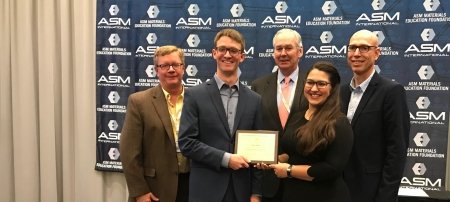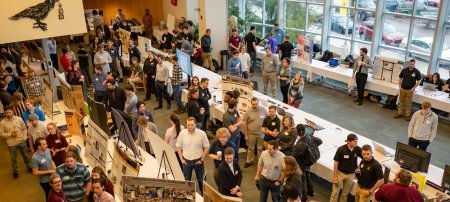Michigan Tech Wins SAE Aero East Competition
After years of hard work, Michigan Tech’s SAE Aero team has truly taken off. The students flew their radio-controlled plane to a third-place finish in the Society of Automotive Engineers’ Aero Design West, held in March in Van Nuys, Calif. Then they soared to first place in Aero Design East, held May 4-6 in Ft. Worth, Texas.
The Michigan Tech team competes in the regular class; awards are also given in the open and micro classes.
“Our SAE Aero team has really progressed over the last four or five years,” said their advisor, Stephen Stackhouse, associate director for corporate development.
The Aero Design Competition challenges engineering students to design and build a radio-controlled aircraft that can take off and land while carrying as much cargo as possible.
All the planes must meet certain criteria, said Raymon Smith, who was the design leader for Michigan Tech’s entry. This year, they had to have a 1,000-square-inch lifting area, an O.S. 61 FX engine and a cargo volume of 4-by-4-by-16 inches. “From that point on, it’s up to the teams,” said Smith, a senior majoring in both electrical and mechanical engineering.
They attempt to take off and land their plane, both loaded with cargo and empty, and to predict how much payload they can carry. In addition, they present oral and written technical reports.
“This is my fifth year on the team, and I’ve seen a lot of growth, from fighting to be in the middle to making it to the top,” Smith said. Over the years, the team has worked to maximize lift, minimize drag, and reduce weight by experimenting with different materials and designs. “Our plane is mostly carbon fiber--most teams are balsa or fiberglass,” he said. “Ours had the simplest design and was the best looking at the competition.”
He credits their success to dogged research and efforts to find funding sources around campus. “Steve Stackhouse has helped us out a lot,” Smith said. “We got an advanced controller through him that was donated by industry.”
Because flying radio-controlled planes is not a winter sport, the team did not get to test its entry until Aero Design West, where they took third place. Then they used what they learned to win the gold in Ft. Worth. “It was great to hold both awards, know that I designed most of the plane, and that a strong team effort built it,” Smith said.
In addition to good materials, the team focused on reliability. “In the past, we had parts that weren’t rugged enough to handle takeoffs and landings, and we learned a lot from that,” he said. “It really came together.”
Victory was all the sweeter because of the caliber of the competition. Schools from throughout the world entered, and many had the benefit of aerospace programs. The Michigan Tech team made an extra effort to learn aerospace engineering principles and then used fundamentals of mechanical engineering to give themselves an edge. “We really optimized the structure, maintaining rigidity while maximizing strength,” Smith said.
Not everyone did. “A few planes fell apart in mid-air,” he said. “They’d make a sharp turn, and the wings would fold up.”
Michigan Tech’s facilities, especially the space in the MEEM subbasement, allowed the team to perform that all-important preliminary testing that was key to its ultimate success, Smith said.
Smith would like to fly real planes someday. “Once I graduate, I’d like to get my pilot’s license,” he said, “and eventually design my own aircraft.”
Michigan Technological University is an R1 public research university founded in 1885 in Houghton, and is home to nearly 7,500 students from more than 60 countries around the world. Consistently ranked among the best universities in the country for return on investment, Michigan's flagship technological university offers more than 185 undergraduate and graduate degree programs in science and technology, engineering, computing, forestry, business, health professions, humanities, mathematics, social sciences, and the arts. The rural campus is situated just miles from Lake Superior in Michigan's Upper Peninsula, offering year-round opportunities for outdoor adventure.




Comments